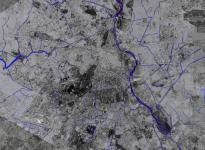The aim of this initiative is to present the hidden opportunity that lies within Delhi by establishing a green and sustainable network through the city.
The Proposal: To use Delhis neglected Nullah network to fundamentally transform the city. Delhi has 18 main nullahs with over 15,000 branches, which were constructed 7 centuries ago by the Tughlaq dynasty. The nullah network is 350km long, contiguous and criss-crosses the national capital. Currently, the nullahs are just unhygenic drains that are seen as a problem by the citizens of Delhi - they smell, breed mosquitos, pollute the Yamuna and so on. However, a relatively small investment can turn the nullahs into a valuable asset for the common citizen. The necessary changes are:
1) Alternative Transport Network: Create walking/cycling paths on these nullahs to provide communters with last mile connectivity to public transport (buses and metro). This will significantly improve the effectiveness of the existing public transport. Furthermore, people will be able to walk/cycle for short distances (and it will be an enjoyable experience). Since the nullah network is 350km long - this would be a very important contribution to the lives of the common citizens.
2) Alternative Environmental Network: Use a system of organic reedbeds and aerators to clean the sewage entering the nullahs. This is a well established system and it is both environment-friendly and cheap. This will dramatically improve public health in the city as well as help replenish aquifers. This will also reduce the need to spend large sums on building sewage plants at the Yamuna.
3) Alternative Cultural Network: The new network could be used to trigger a number of new urban activities ranging from tourism to sports. For instance, some of the nullahs are 700 years old and were built to provide water to Delhis old cities. Thus, many of the citys famous archaeological sites are situated on the nullah network. Most major cultural venues in the city can be interconnected through this network, including Commonwealth Games venues, historical monuments, museums, theatres, stadiums, etc. We could use the new walking network to drive next generation tourism.
2009
1900
.jpg)
.jpg)

.jpg)
.jpg)
.jpg)
.jpg)
